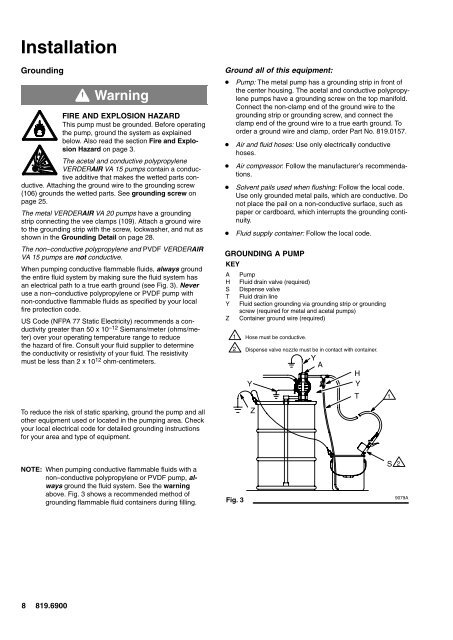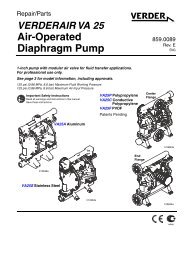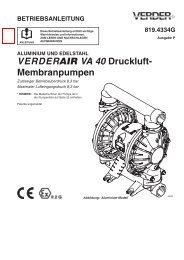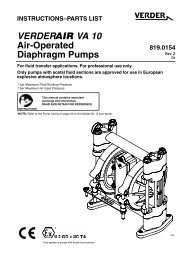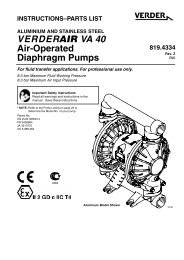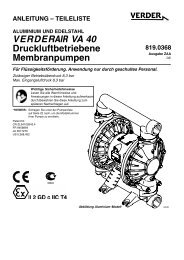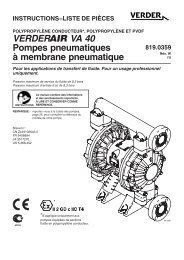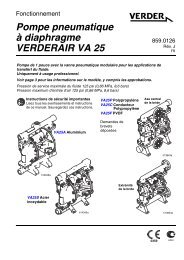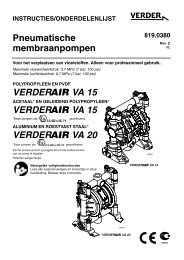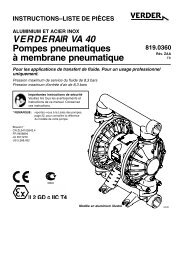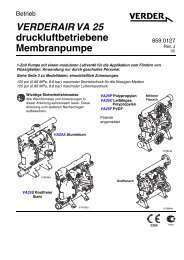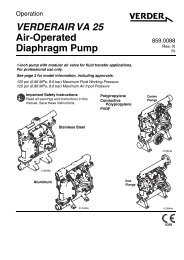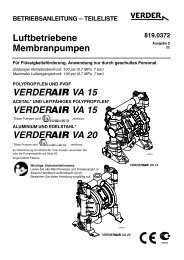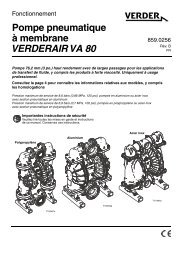Air-Operated Diaphragm Pumps VERDER VA 15 VERDER VA 15 VERDER VA 20
verderair va 20 - Double Diaphragm Pump
verderair va 20 - Double Diaphragm Pump
Create successful ePaper yourself
Turn your PDF publications into a flip-book with our unique Google optimized e-Paper software.
Installation<br />
Grounding<br />
Warning<br />
FIRE AND EXPLOSION HAZARD<br />
This pump must be grounded. Before operating<br />
the pump, ground the system as explained<br />
below. Also read the section Fire and Explosion<br />
Hazard on page 3.<br />
The acetal and conductive polypropylene<br />
<strong>VERDER</strong>AIR <strong>VA</strong> <strong>15</strong> pumps contain a conductive<br />
additive that makes the wetted parts conductive.<br />
Attaching the ground wire to the grounding screw<br />
(106) grounds the wetted parts. See grounding screw on<br />
page 25.<br />
The metal <strong>VERDER</strong>AIR <strong>VA</strong> <strong>20</strong> pumps have a grounding<br />
strip connecting the vee clamps (109). Attach a ground wire<br />
to the grounding strip with the screw, lockwasher, and nut as<br />
shown in the Grounding Detail on page 28.<br />
The non–conductive polypropylene and PVDF <strong>VERDER</strong>AIR<br />
<strong>VA</strong> <strong>15</strong> pumps are not conductive.<br />
When pumping conductive flammable fluids, always ground<br />
the entire fluid system by making sure the fluid system has<br />
an electrical path to a true earth ground (see Fig. 3). Never<br />
use a non–conductive polypropylene or PVDF pump with<br />
non-conductive flammable fluids as specified by your local<br />
fire protection code.<br />
US Code (NFPA 77 Static Electricity) recommends a conductivity<br />
greater than 50 x 10 –12 Siemans/meter (ohms/meter)<br />
over your operating temperature range to reduce<br />
the hazard of fire. Consult your fluid supplier to determine<br />
the conductivity or resistivity of your fluid. The resistivity<br />
must be less than 2 x 10 12 ohm-centimeters.<br />
To reduce the risk of static sparking, ground the pump and all<br />
other equipment used or located in the pumping area. Check<br />
your local electrical code for detailed grounding instructions<br />
for your area and type of equipment.<br />
Ground all of this equipment:<br />
Pump: The metal pump has a grounding strip in front of<br />
the center housing. The acetal and conductive polypropylene<br />
pumps have a grounding screw on the top manifold.<br />
Connect the non-clamp end of the ground wire to the<br />
grounding strip or grounding screw, and connect the<br />
clamp end of the ground wire to a true earth ground. To<br />
order a ground wire and clamp, order Part No. 819.0<strong>15</strong>7.<br />
<br />
<br />
<br />
<br />
KEY<br />
A<br />
H<br />
S<br />
T<br />
Y<br />
<strong>Air</strong> and fluid hoses: Use only electrically conductive<br />
hoses.<br />
<strong>Air</strong> compressor: Follow the manufacturer’s recommendations.<br />
Solvent pails used when flushing: Follow the local code.<br />
Use only grounded metal pails, which are conductive. Do<br />
not place the pail on a non-conductive surface, such as<br />
paper or cardboard, which interrupts the grounding continuity.<br />
Fluid supply container: Follow the local code.<br />
GROUNDING A PUMP<br />
Z<br />
Pump<br />
Fluid drain valve (required)<br />
Dispense valve<br />
Fluid drain line<br />
Fluid section grounding via grounding strip or grounding<br />
screw (required for metal and acetal pumps)<br />
Container ground wire (required)<br />
1 Hose must be conductive.<br />
2<br />
Dispense valve nozzle must be in contact with container.<br />
Y<br />
Z<br />
Y<br />
A<br />
H<br />
Y<br />
T<br />
1<br />
NOTE: When pumping conductive flammable fluids with a<br />
non–conductive polypropylene or PVDF pump, always<br />
ground the fluid system. See the warning<br />
above. Fig. 3 shows a recommended method of<br />
grounding flammable fluid containers during filling.<br />
Fig. 3<br />
S<br />
2<br />
9079A<br />
8 819.6900


